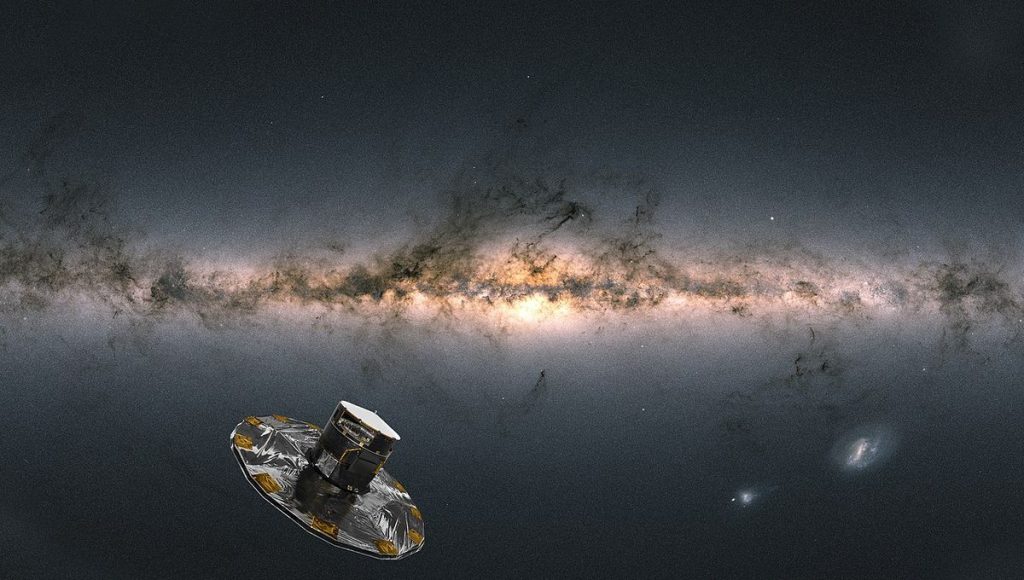RIP Gaia: Revolutionary Mission That Mapped The Galaxy To Come To An End This Week – IFLScience

CLOSEWe have emailed you a PDF version of the article you requested.Please check your spam or junk folder You can also addnewsletters@iflscience.comto your safe senders list to ensure you never miss a message from us.CLOSEComplete the form below and we will email you a PDF versionGET PDFCancel and go backIFLScience needs the contact information you provide to us to contact you about our products and services. You may unsubscribe from these communications at any time.For information on how to unsubscribe, as well as our privacy practices and commitment to protecting your privacy, check out ourPrivacy PolicyCLOSEComplete the form below to listen to the audio version of this articleListenCancel and go backIFLScience needs the contact information you provide to us to contact you about our products and services. You may unsubscribe from these communications at any time.For information on how to unsubscribe, as well as our privacy practices and commitment to protecting your privacy, check out ourPrivacy PolicyAdvertisementSearchSubscribe today for our Weekly Newsletter in your inbox!Subscribe today for our Weekly Newsletter in your inbox!Dr. Alfredo CarpinetiDr. Alfredo CarpinetiSenior Staff Writer & Space CorrespondentAlfredo (he/him) has a PhD in Astrophysics on galaxy evolution and a Master’s in Quantum Fields and Fundamental Forces.BookView full profileBookRead IFLScience Editorial PolicySenior Staff Writer & Space CorrespondentKaty EvansManaging EditorKaty is Managing Editor at IFLScience where she oversees editorial content from News articles to Features, and even occasionally writes some.BookView full profileBookRead IFLScience Editorial PolicyDOWNLOAD PDF VERSIONArtist’s impression of Gaia, with the most detailed map of the Milky Way, revealing the composition of over 1.8 billion stars, which it composed.Image Credit: ESA/ATG medialabDOWNLOAD PDF VERSIONThe European Space Agency’s Gaia mission has almost completely depleted the cold gas propellant that kept it spinning and able to scan the sky, so it has decided to nominally end science operations of this revolutionary mission on January 15. It will truly be the end of an era.Gaia is first and foremost a map maker; its mission to create the largest, most detailed three-dimensional map of our galaxy, cataloging the position, motion, temperature, and composition of over 1 billion stars. It allowed astronomers to not only understand what the Milky Way looks like today but also work out its past.Launched in 2013, Gaia was initially a five-year mission but was extended multiple times due to its success. Amongst its many achievements is tracking the motion of groups of stars, revealing ancient galactic collisions, discovering potentially hundreds of moons around asteroids, finding the two closest black holes to Earth (which may even be a new class of black holes), and finding the ancient heart of the Milky Way. Because so far only a small part of the data collected by Gaia have been released and therefore scientifically explored, it is yet impossible to grasp the full magnitude of Gaia’s legacy.The space telescope also cast its eye out further than our galaxy. Data from Gaia has shown that one of the satellites of the Milky Way, the Small Magellanic Cloud, might be two galaxies, not one. It even saw a bunch of stuff that it was not designed to see, allowing astronomers to study stellar clusters as a whole and even some of the most distant quasars. The galactic map maker has changed our understanding of the galaxy, its past, neighborhood, and even provided new insights into the Solar System. After 10.5 years of observations, Gaia’s eye on the Solar System, the Milky Way, and beyond will turn dark. But it’s not the last we’ll hear from its data.”Because so far only a small part of the data collected by Gaia have been released and therefore scientifically explored, it is yet impossible to grasp the full magnitude of Gaia’s legacy,” Dr Johannes Sahlmann, Gaia Process scientist with ESA, told IFLScience.”It is clear, however, that the successful operations of the Gaia spacecraft over the past 11 years have allowed us to secure an unprecedented dataset of immense and long-lasting scientific value.” It’s Gaia Data Release 4, coming in 2026 and covering 5.5 years of observations, that will make new groundbreaking science possible. The final data release spanning the whole 10.5 years will be published around the end of the decade. Incredibly, all the data from Gaia is open access, which means that anyone can access it, widening the possibilities of what we might find in it. The successes of Gaia will help inspire new generations of scientists to make a successor mission a reality and to continue to push the boundaries of space astrometry, in the spirit of Gaia’s legacy.”With the two remaining major data releases, Gaia will continue to have a transformative impact on the study of the Milky Way, on our understanding of stellar formation and evolution, and on the research field of multiple stars and extrasolar planets in the vicinity of the Sun, to name only a few,” Dr Sahlmann continued”The successes of Gaia will help inspire new generations of scientists to make a successor mission to Gaia a reality and to continue to push the boundaries of space astrometry, in the spirit of Gaia’s legacy.” Still, humanity will not stop looking at the stars. The Vera C. Rubin observatory – whose first light is just months away – will catalog 17 billion stars in the Milky Way, although not quite as accurately as the billion and more of Gaia.For those numbers and that precision, we need to hope that the proposed GaiaNIR mission, which will do what Gaia did but in infrared, will move forward. The mission will build on the work from Gaia but it will go deeper into the plane of the Milky Way, as the pesky cosmic dust that obstructs our view is not bothersome in infrared. A good example of this is how JWST, which sees in infrared, builds upon Hubble’s legacy but can see farther than Hubble, which sees in visible light.“Even though Gaia is very brilliant and is revolutionizing everything, it’s really only measuring 1 percent of the galaxy,” GaiaNIR proposer Professor David Hobbs, from the University of Lund, told IFLScience at the International Astronomical Union General Assembly last year. “The important thing about infrared, of course, is that all of the really dynamically interesting parts of the galaxy, they’re all lying in the galactic plane, and this is where all the dust is as well. Gaia is very good at seeing out of the galaxy, but it’s actually not that very good at seeing into the galaxy. It needs, in a sense, a pair of glasses to see through the dust, and that’s what the near-infrared detectors will allow.”Gaia has been a triumph and its legacy will shape astronomy for decades to come.Astronomy,European Space Agency,Gaialink to articlelink to articlelink to articleAdvertisementAdvertisementAdvertisementlink to articlelink to articlelink to articleSign up today to get weekly science coverage direct to your inbox© 2025 IFLScience. All Rights Reserved. RSS






